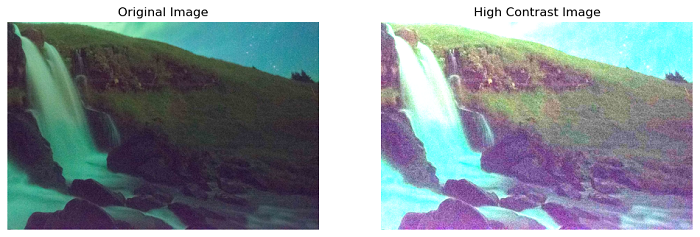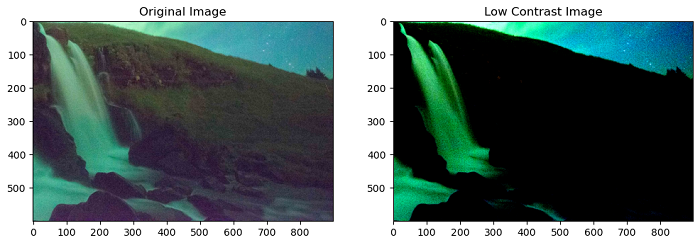
- Scikit Image – Introduction
- Scikit Image - Image Processing
- Scikit Image - Numpy Images
- Scikit Image - Image datatypes
- Scikit Image - Using Plugins
- Scikit Image - Image Handlings
- Scikit Image - Reading Images
- Scikit Image - Writing Images
- Scikit Image - Displaying Images
- Scikit Image - Image Collections
- Scikit Image - Image Stack
- Scikit Image - Multi Image
- Scikit Image - Data Visualization
- Scikit Image - Using Matplotlib
- Scikit Image - Using Ploty
- Scikit Image - Using Mayavi
- Scikit Image - Using Napari
- Scikit Image - Color Manipulation
- Scikit Image - Alpha Channel
- Scikit Image - Conversion b/w Color & Gray Values
- Scikit Image - Conversion b/w RGB & HSV
- Scikit Image - Conversion to CIE-LAB Color Space
- Scikit Image - Conversion from CIE-LAB Color Space
- Scikit Image - Conversion to luv Color Space
- Scikit Image - Conversion from luv Color Space
- Scikit Image - Image Inversion
- Scikit Image - Painting Images with Labels
- Scikit Image - Contrast & Exposure
- Scikit Image - Contrast
- Scikit Image - Contrast enhancement
- Scikit Image - Exposure
- Scikit Image - Histogram Matching
- Scikit Image - Histogram Equalization
- Scikit Image - Local Histogram Equalization
- Scikit Image - Tinting gray-scale images
- Scikit Image - Image Transformation
- Scikit Image - Scaling an image
- Scikit Image - Rotating an Image
- Scikit Image - Warping an Image
- Scikit Image - Affine Transform
- Scikit Image - Piecewise Affine Transform
- Scikit Image - ProjectiveTransform
- Scikit Image - EuclideanTransform
- Scikit Image - Radon Transform
- Scikit Image - Line Hough Transform
- Scikit Image - Probabilistic Hough Transform
- Scikit Image - Circular Hough Transforms
- Scikit Image - Elliptical Hough Transforms
- Scikit Image - Polynomial Transform
- Scikit Image - Image Pyramids
- Scikit Image - Pyramid Gaussian Transform
- Scikit Image - Pyramid Laplacian Transform
- Scikit Image - Swirl Transform
- Scikit Image - Morphological Operations
- Scikit Image - Erosion
- Scikit Image - Dilation
- Scikit Image - Black & White Tophat Morphologies
- Scikit Image - Convex Hull
- Scikit Image - Generating footprints
- Scikit Image - Isotopic Dilation & Erosion
- Scikit Image - Isotopic Closing & Opening of an Image
- Scikit Image - Skelitonizing an Image
- Scikit Image - Morphological Thinning
- Scikit Image - Masking an image
- Scikit Image - Area Closing & Opening of an Image
- Scikit Image - Diameter Closing & Opening of an Image
- Scikit Image - Morphological reconstruction of an Image
- Scikit Image - Finding local Maxima
- Scikit Image - Finding local Minima
- Scikit Image - Removing Small Holes from an Image
- Scikit Image - Removing Small Objects from an Image
- Scikit Image - Filters
- Scikit Image - Image Filters
- Scikit Image - Median Filter
- Scikit Image - Mean Filters
- Scikit Image - Morphological gray-level Filters
- Scikit Image - Gabor Filter
- Scikit Image - Gaussian Filter
- Scikit Image - Butterworth Filter
- Scikit Image - Frangi Filter
- Scikit Image - Hessian Filter
- Scikit Image - Meijering Neuriteness Filter
- Scikit Image - Sato Filter
- Scikit Image - Sobel Filter
- Scikit Image - Farid Filter
- Scikit Image - Scharr Filter
- Scikit Image - Unsharp Mask Filter
- Scikit Image - Roberts Cross Operator
- Scikit Image - Lapalace Operator
- Scikit Image - Window Functions With Images
- Scikit Image - Thresholding
- Scikit Image - Applying Threshold
- Scikit Image - Otsu Thresholding
- Scikit Image - Local thresholding
- Scikit Image - Hysteresis Thresholding
- Scikit Image - Li thresholding
- Scikit Image - Multi-Otsu Thresholding
- Scikit Image - Niblack and Sauvola Thresholding
- Scikit Image - Restoring Images
- Scikit Image - Rolling-ball Algorithm
- Scikit Image - Denoising an Image
- Scikit Image - Wavelet Denoising
- Scikit Image - Non-local means denoising for preserving textures
- Scikit Image - Calibrating Denoisers Using J-Invariance
- Scikit Image - Total Variation Denoising
- Scikit Image - Shift-invariant wavelet denoising
- Scikit Image - Image Deconvolution
- Scikit Image - Richardson-Lucy Deconvolution
- Scikit Image - Recover the original from a wrapped phase image
- Scikit Image - Image Inpainting
- Scikit Image - Registering Images
- Scikit Image - Image Registration
- Scikit Image - Masked Normalized Cross-Correlation
- Scikit Image - Registration using optical flow
- Scikit Image - Assemble images with simple image stitching
- Scikit Image - Registration using Polar and Log-Polar
- Scikit Image - Feature Detection
- Scikit Image - Dense DAISY Feature Description
- Scikit Image - Histogram of Oriented Gradients
- Scikit Image - Template Matching
- Scikit Image - CENSURE Feature Detector
- Scikit Image - BRIEF Binary Descriptor
- Scikit Image - SIFT Feature Detector and Descriptor Extractor
- Scikit Image - GLCM Texture Features
- Scikit Image - Shape Index
- Scikit Image - Sliding Window Histogram
- Scikit Image - Finding Contour
- Scikit Image - Texture Classification Using Local Binary Pattern
- Scikit Image - Texture Classification Using Multi-Block Local Binary Pattern
- Scikit Image - Active Contour Model
- Scikit Image - Canny Edge Detection
- Scikit Image - Marching Cubes
- Scikit Image - Foerstner Corner Detection
- Scikit Image - Harris Corner Detection
- Scikit Image - Extracting FAST Corners
- Scikit Image - Shi-Tomasi Corner Detection
- Scikit Image - Haar Like Feature Detection
- Scikit Image - Haar Feature detection of coordinates
- Scikit Image - Hessian matrix
- Scikit Image - ORB feature Detection
- Scikit Image - Additional Concepts
- Scikit Image - Render text onto an image
- Scikit Image - Face detection using a cascade classifier
- Scikit Image - Face classification using Haar-like feature descriptor
- Scikit Image - Visual image comparison
- Scikit Image - Exploring Region Properties With Pandas
Scikit Image - Contrast
Contrast in an image refers to the difference in brightness and color between different elements within the image. In a high-contrast image, the difference between the lightest and darkest areas is significant, resulting in well-defined edges and a more visual appearance. On the other hand, in a low-contrast image, the range between light and dark is minimal, resulting in a flatter and less visual appearance of the image elements.
To increase and decrease the contrast of an image using the scikit-image library, you can use the rescale_intensity() method from the exposure module.
The skimage.exposure.rescale_intensity() method
The exposure.rescale_intensity() function in scikit-image is used to adjust the intensity range of an image.
Syntax
Following is the syntax of this method −
skimage.exposure.rescale_intensity(image, in_range='image', out_range='dtype')
Parameters
- image: The input image array whose intensity range is adjusted.
- In_range, out_range: (str or 2-tuple, optional) Specifies the minimum and maximum intensity values of the input image. It can take several forms.
- 'image': This uses the minimum and maximum intensity values present in the input image as the range.
- 'dtype': This uses the minimum and maximum values allowed by the image's data type (dtype) as the range.
- dtype-name: This uses the intensity range based on the desired dtype. Must be a valid key in DTYPE_RANGE.
- 2-tuple: This uses the range_values as the explicit minimum and maximum intensities.
Return Value
It returns an array that represents the image after rescaling its intensity levels. The output image has the same data type (dtype) as the input image.
Example
The following example demonstrates how to use the exposure.rescale_intensity() method to increase the contrast of an image.
from skimage import io, exposure
import matplotlib.pyplot as plt
# Load the input image
image = io.imread('Images/image.jpg')
# Increase contrast by stretching the intensity range
high_contrast_image = exposure.rescale_intensity(image, in_range=(0, 100), out_range=(0, 1))
# Display the original and high-contrast images
fig, axes = plt.subplots(1, 2, figsize=(12, 6))
ax1, ax2 = axes.ravel()
ax1.imshow(image, cmap='gray')
ax1.set_title('Original Image')
ax1.set_axis_off()
ax2.imshow(high_contrast_image, cmap='gray')
ax2.set_title('High Contrast Image')
ax2.set_axis_off()
plt.show()
Output
On executing the above program, you will get the following output −

Example
The following example demonstrates how to use the exposure.rescale_intensity() method to decrease the contrast of an image.
from skimage import io, exposure
import matplotlib.pyplot as plt
# Load the image
image = io.imread('Images/image.jpg')
# Decrease contrast by compressing the intensity range
low_contrast_image = exposure.rescale_intensity(image, in_range=(100, 200), out_range=(0, 1))
# Display the original and low-contrast images
fig, axes = plt.subplots(1, 2, figsize=(12, 5))
ax1, ax2 = axes.ravel()
ax1.imshow(image, cmap='gray')
ax1.set_title('Original Image')
ax2.imshow(low_contrast_image, cmap='gray')
ax2.set_title('Low Contrast Image')
plt.show()
Output
On executing the above program, you will get the following output −
